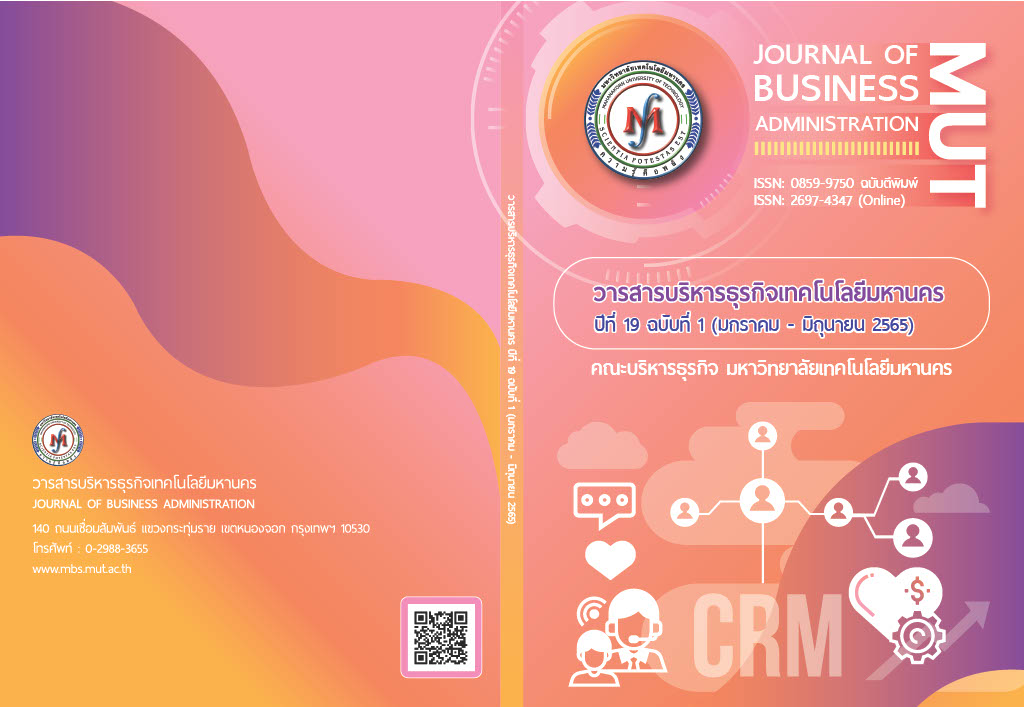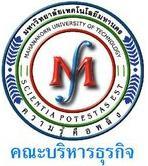The Carbon Offsetting Behavior of Thai Passengers Influenced by Carbon offset Program Knowledge with Attitude as a Mediator
Keywords:
Knowledge, Attitude, Behavior, Carbon offsetAbstract
This study intends to examine the relationship between knowledge, attitude and carbon offsetting behavior of Thai passengers. This quantitative research applied KAB (Knowledge-Attitude-Behavior) theory. The data were collected using the purposive selection technique from 222 participants (Female 65.9% and Male 34.1%). The online questionnaire was used as a research instrument. The Partial Least Square - Structural Equation Modeling (PLS-SEM) was used to test hypotheses. The result showed that carbon offset program knowledge had a significant impact on the willing to offset flight carbon of Thai passengers (ß = 0.292). The attitude toward carbon offset partially mediates between carbon offset program knowledge and the willing to offset flight carbon (VAF = 0.412). The result in this present study is beneficial to the pro-environmental strategy for concerned organizations in the aviation industry especially the commercial airlines to manage passengers’ carbon offsetting behavior and their carbon offset program. The finding of this research is also useful for the governmental organizations that concern about environmental issues to enlarge environmental knowledge and promote the pro-environmental attitude in the policy.
References
องค์การบริหารก๊าซเรือนกระจก. 2559. สร้างคาร์บอนเครดิตในบ้าน. สืบค้นวันที่ 20 มิถุนายน 2564 จาก http://www.tgo.or.th/2020/index.php/th/post/สร้าง-คาร์บอนเครดิต-ในบ้าน-270
Abdullah, S. I. N. W., Samdin, Z., Teng, P. and Heng, B. 2019. The impact of knowledge, attitude, consumption values and destination image on tourists’ responsible environmental behavior intention. Management Science Letters. Vol. 9. No. 9. 1461 – 1476.
Alzghoul B.I and Abdullah N.A. 2016. Pain Management Practices by Nurses: An Application of the Knowledge, Attitude and Practices (KAP) Model. Glob J Health Sci. Vol. 26;8. No. 6. 154 – 160. Retrieved May 25, 2021 from DOI: 10.5539/gjhs.v8n6p154
Angelovska, J., Sotiroska, S. and Angelovska, N. 2012. The Impact of Environmental Concern and Awareness on Consumer Behavior. J. Int. Environmental Application & Science.
Brack, D. 2019. Forests and Climate Change. In Proceedings of Background Study Prepared for the Fourteenth Session of the United Nations Forum on Forests. New York, NY: United Nations Forum on Forests.
Chen, F. Y. 2013. The intention and determining factors for airline passengers' participation in carbon offset schemes. Journal of Air Transport Management, 29, 17 - 22.
Cheung, M. F. and To, W. M. 2019. An extended model of value-attitude-behavior to explain Chinese consumers’ green purchase behavior. Journal of Retailing and Consumer Services. Vol. 50. 145 -153.
Chin, W. W. 1998. The partial least squares approach to structural equation modeling. Modern methods for business research. Vol. 295 No. 2 295 – 336.
Dakduk, S., Horst, E. T., Santalla, Z., Molina, G., & Malavé, J. 2017. Customer behavior in electronic commerce: a Bayesian approach. Journal of theoretical and applied electronic commerce research. 12 (2) 1 - 20.
Davison, L., Littleford, C., & Ryley, T. 2014. Air travel attitudes and behaviors: The development of environment-based segments. Journal of Air Transport Management. Vol. 36 P. 18
Eagly, A. H. and Chaiken, S. 1993. The psychology of attitudes. Harcourt Brace Jovanovich College Publishers.
Environmental Protection Agency – EPA. 2019. Overview of Greenhouse Gases. Retrieved May 25, 2021 from: https://www.epa.gov/ghgemissions/overviewgreenhouse-gases.
Fang, W.-T., Lien, C.-Y., Huang, Y.-W., Han, G., Shyu, G.-S., Chou, J.-Y., Ng, E. 2018. Environmental Literacy on Ecotourism: A Study on Student Knowledge, Attitude, and Behavioral Intentions in China and Taiwan. Sustainability. Vol. 10. No. 6. Retrieved June 1, 2021 from https://doi.org/10.3390/su10061886
Fornell, C. and Larcker, D. F. 1981. Evaluating Structural Equation Models with Unobservable and Measurement Error. Journal of Marketing Research. 161 – 188.
George, D. and Mallery, P. 2010. SPSS for Windows step by step. A simple study guide and reference. (10. Baskı). GEN, Boston, MA: Pearson Education, Inc.
Hair, J. F. (Jr.), Hult, G. T. M., Ringle, C. M. and Sarstedt, M. 2014. A Primer on Partial Least Squares Structural Equation Modeling (PLS-SEM). California, CA: Sage Publications.
Hair, J.F., Ringle, C.M. & Sarstedt, M. 2011. PLS-SEM: Indeed a Silver Bullet. Journal of Marketing Theory and Practice. Vol. 19, No. 2 (139 – 151). Retrieved August 10, 2021 from https://doi.org/10.2753/MTP1069-6679190202
Hair, J. F., Ringle, C. M., & Sarstedt, M. 2013. Partial least squares structural equation modeling: Rigorous applications, better results and higher acceptance. Long range planning. 46 (1 - 2), 1 - 12.
Hair, J.F., William, C.B., Barry, J.B. & Anderson, R.E. 2010. Multivariate Data Analysis. Englewood Cliffs, NJ, USA: Prentice Hall; 2010.
Hausfather, Z. 2021. Global Emission: Global CO2 emissions have been flat for a decade, new data reveals. Retrieved May 10, 2021 from https://www.carbonbrief.org/global-co2-emissions-have-been-flat-for-a-decade-new-data-reveals
Henseler, J., Hubona, G. and Ray, P. A. 2016. Using PLS Path Modeling in New Technology Research: updated guidelines. Industrial Management & Data Systems. Retrieved June 20, 2021 from https://www.emerald.com/insight/content/doi/10.1108/IMDS-09-20150382/full/html
Höck, M. and Ringle, C. M. 2006, September. Strategic networks in the software industry: An empirical analysis of the value continuum. In IFSAM VIIIth World Congress 28.
Hsiu-Yueh Liu, Jung-Ren Chen, Szu-Yu Hsiao and Shun-Te Huang. 2017. Caregivers' oral health knowledge, attitude and behavior toward their children with disabilities. Journal of Dental Sciences. Vol. 12. 388-395. Retrieved June 1, 2021 from https://doi.org/10.1016/j.jds.2017.05.003
IATA Official Website. 2008. Enabling Voluntary Carbon Offsetting. Frequently Asked Questions. Retrieved May 10, 2021 from https://www.iata.org/en/programs/environment/carbon-offset/
Iyer, L.S. 2018. Knowledge, Attitude and Behaviour (KAB) of Student Community Towards Electronic Waste - A Case Study. Indian Journal of Science and Technology. Vol. 11. No. 10. Retrieved June 1, 2021 from DOI: 10.17485/ijst/2018/v11i10/109038
Kim, T. R., Ross, J. A. and Smith, D. P. 1969. KOREA: Trends in Four National KAP Surveys, 1964-67. Studies in Family Planning. Vol. 1. No. 43. 6–11. Retrieved June 20, 2021 from https://doi.org/10.2307/1965090
Kim, Y., Yun, S., & Lee, J. 2014. Can companies induce sustainable consumption? The impact of knowledge and social embeddedness on airline sustainability programs in the US. Sustainability. 6 (6) 3338-3356.
Kemm J, Close A. 1995. Health promotion: Theory & practice. Palgrave.
Kendra. C. 2021. Attitudes and Behavior in Psychology. Retrieved June 12, 2021 from https://www.verywellmind.com/attitudes-how-they-form-change-shape-behavior-2795897
Kulp, S. A., & Strauss, B. H. 2019. New elevation data triple estimates of global vulnerability to sea-level rise and coastal flooding. Nature communications. 10 (1) 1 - 12.
Liu, H., Xu, X., Liu, D., Rao, Y., Reis, C., Sharma, M., and Zhao, Y. 2018. Nutrition-Related Knowledge, Attitudes, and Practices (KAP) among Kindergarten Teachers in Chongqing, China: A Cross-Sectional Survey. International Journal of Environmental Research and Public Health. Vol. 15. No. 4. 615. Retrieved June 1, 2021 from doi:10.3390/ijerph15040615
Nonaka I, Takeuchi H. 1995. The knowledge-creating company: How Japanese companies create the dynamics of innovation. New York: Oxford University Press.
Pan, Mi and Pan, Wei. 2020. Knowledge, attitude and practice towards zero carbon buildings: Hong Kong case. Journal of Cleaner Production. Vol. 274 No. 122819 10.1016/j.jclepro.2020.122819.
Pan, S. L., Chou, J., Morrison, A. M., Huang, W. S. and Lin, M. C. 2018. Will the future be greener? The environmental behavioral intentions of university tourism students. Sustainability. Vol. 10 No. 3
– 17.
Pawelek, K. A., Salmeron, C. and Valle, S. Del. 2015. Connecting within and between-hosts dynamics in the
influenza infection-staged epidemiological models with behavior change. Journal of Coupled Systems
and Multiscale Dynamics, 3 (3), pp. 233 – 243. Retrieved June 12, 2021 from doi:10.1166/jcsmd.2015.1082
Riskos, K., Dekoulou, P. E., Mylonas, N. and Tsourvakas, G. 2021. Ecolabels and the Attitude Behavior Relationship towards Green Product Purchase: A Multiple Mediation Model. Sustainability. Vol. 13 No. 12 6867.
Ross, J. A., Han, D. W., Keeny, S. M., Cernada, G. P., Hsu, T. C., & Sun, T. H. 1970. Korea/Taiwan 1969: report on the national family planning programs. Studies in family planning. 1 (54) 1 - 16.
Sai-Leung Ng. 2019. Predicting multi-family dwelling recycling behaviors using structural equation modelling: A case study of Hong Kong. Resources, Conservation and Recycling. Vol. 149. 468 - 478. Retrieved June 1, 2021 from https://doi.org/10.1016/j.resconrec.2019.06.007
Sanlier, N. and Baser, F. 2020. The Relationship Among Food Safety Knowledge, Attitude and Behavior of Young Turkish Women. Journal of the American College of Nutrition. Vol. 39. No.3. 224 - 234 Retrieved Sep 20, 2021 from DOI: 10.1080/07315724.2019.1639084
Thai Airways website. 2018. THAI Voluntary Carbon Offset Program. Retrieved 20 June 2021 from https://ir.thaiairways.com/wp-content/uploads/2021/09/20190326-thai-sdreport2018-en-1-1.pdf
United Nations Official Website. 2021. Climate Action: COP26, it’s almost here. Retrieved May 10, 2021 from https://www.un.org/en/climatechange/cop26
Van Birgelen, M., Semeijn, J., & Behrens, P. 2011. Explaining pro-environment consumer behavior in air travel. Journal of Air Transport Management. 17 (2), 125 – 128.
Wei, Y.M., Han, R., Wang, C. et al. 2020. Self-preservation strategy for approaching global warming targets in the post-Paris Agreement era. Nature Communications. Vol. 11 Retrieved May 10, 2021 from https://doi.org/10.1038/s41467020-15453-z
Wen X., Wang F., Li X. and Gu H. 2021. Study on the Knowledge, Attitude, and Practice (KAP) of Nursing Staff and Influencing Factors on COVID-19. Frontiers in Public Health. Retrieved June 1, 2021 from https://www.frontiersin.org/article/10.3389/fpubh.2020.560606
Wong, K. K. K. 2019. Mastering partial least squares structural equation modeling (PLS-Sem) with Smartpls in 38 Hours. IUniverse.
Yeung, J. 2020. Australia's deadly wildfires are showing no signs of stopping. Here's what you need to know. CNN. January 14, 2020. Retrieved May 10, 2021 from: https://edition.cnn.com/2020/01/01/australia/australia-fires-explainerintl-hnkscli/index.html.
Yi Q, Hohashi N. 2018. Comparison of perceptions of domestic elder abuse among healthcare workers based on the Knowledge-Attitude-Behavior (KAB) model. PLoS ONE. Vol. 13 No. 11 Retrieved June 1, 2021 from https://doi.org/10.1371/journal.pone.0206640
Yong, C. C., Yew, S. Y., & Wee, C. K. (2018). Financial knowledge, attitude and behavior of young working adults in Malaysia. Institutions and Economies. 10 (4).
Zhao, A., Szeto, I., Wang, Y., Li, C., Pan, M., Li, T., … and Zhang, Y. 2017. Knowledge, Attitude, and Practice (KAP) of Dairy Products in Chinese Urban Population and the Effects on Dairy Intake Quality. Nutrients. Vol. 9. No. 7. 668. Retrieved June 12, 2021 from doi:10.3390/nu9
Downloads
Published
Issue
Section
License

This work is licensed under a Creative Commons Attribution-NonCommercial-NoDerivatives 4.0 International License.
ข้อความ ข้อคิดเห็น ข้อมูล เนื้อหา รูปภาพ แผนภูมิ แผนผัง เป็นต้น ที่ปรากฏและแสดงในบทความต่างๆ ในวารสารบริหารธุรกิจเทคโนโลยีมหานคร ถือเป็นความรับผิดชอบโดยตรงของผู้เขียนบทความนั้นๆ มิใช่เป็นความรับผิดชอบใดๆ ของวารสารบริหารธุรกิจเทคโนโลยีมหานคร และมหาวิทยาลัยเทคโนโลยีมหานคร
บทความที่ตีพิมพ์ในวารสารบริหารธุรกิจเทคโนโลยีมหานคร ถือเป็นลิขสิทธิ์เฉพาะของคณะบริหารธุรกิจ มหาวิทยาลัยเทคโนโลยีมหานคร หากบุคคลหรือหน่วยงานใดต้องการนำทั้งหมดหรือส่วนใดส่วนหนึ่งไปเผยแพร่ต่อหรือเพื่อกระทำการใดๆ จะต้องได้รับการอนุญาตเป็นลายลักษณ์อักษรจากคณะบริหารธุรกิจ มหาวิทยาลัยเทคโนโลยีมหานครก่อนเท่านั้น


